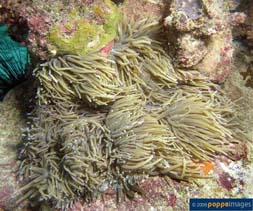| Family: |
Actiniidae () |
| Max. size: |
|
| Environment: |
sessile; marine; depth range - 15 m |
| Distribution: |
Northwest Pacific, Western Central Pacific. |
| Diagnosis: |
Oral disc is usually around 20 to 30 cm in diameter and can grow up to 50 cm in larger individuals. Tentacles are slender, and may appear tightly coiled or curled near the tips. These tentacles are closely arranged at the circumference of the oral disc, gradually becoming sparse or absent towards the mouth. Oral disc and tentacles vary in color from brown, green, to purplish-gray. The striated pattern is due to white stripes radiating from the mouth, which may extend onto the tentacles. Distinctive white spots are present on the body column. |
| Biology: |
In shallow waters, to depths of around 15 meters. Has a symbiotic zooxanthellae, which produces food through photosynthesis. Serves a shelter for several anemone shrimps and fishes (Ref. 125532). |
| IUCN Red List Status: |
Not Evaluated (N.E.) Ref. 123251)
|
| Threat to humans: |
|
| Country info: |
|
Source and more info: www.sealifebase.org. For personal, classroom, and other internal use only. Not for publication.

